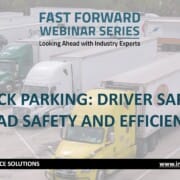8 Tips for Improving Fuel Efficiency
Fuel is one of your biggest expenses in trucking. You run millions of miles every year. At around 70,000 miles of fuel per year per truck, that’s millions of dollars worth of fuel on an annual basis. Better fuel efficiency is major money in your pocket.
8 Tips for Improving Fuel Efficiency
When you can address your fleet MPG, you’re looking at a huge return on investment for your trouble. Improving fuel efficiency by only 0.05% saves you tens of thousands in fuel dollars in that year alone. That’s a fraction of a mile per gallon improvement.
Fuel is such a big budget item that when you move the needle even slightly, you can see enormous changes. This is a great place to focus on when tackling budget reduction.
Here are some of the top issues in improving fuel efficiency:
1 – Check Speed.
This may be a place where drivers—especially your drivers with lower MPGs—need to increase awareness or receive more training. There’s an art to balancing slower, more consistent speeds with deadlines, topography, weather, entering towns, stopping, and slowing. It’s also important to know exactly when coasting is an option, so drivers can disengage the transmission and drop those RPMs whenever it’s safe and wise to do so. Training and retraining on cruise control can help drivers get better at balancing safety and fuel economy.
Finally, check your company culture to make sure it rewards good old-fashioned patience, rather than just miles!
2 – Put Star Drivers Out Front.
In that vein, some companies offer bonuses and other rewards to drivers with the highest MPG results. Identify that person in your company. Offer him or her a bonus. Make a short video to interview that driver to explain his or her tips, tricks, and best practices for other drivers. Drivers will listen to a fellow driver.
3 – Check Cargo Distribution.
Take physics in high school? Maybe most of us didn’t, but we can all understand this one. It’s Trucking Physics 101. Undue and uneven pressure on your truck bed can cause damage and strain to your vehicle parts, premature wear to the truck, and make best driving practices harder to execute and less safe. Make sure drivers are trained to ensure even cargo distribution in their trailers.
4 – “Progress” with Progressive Shifting.
Staying alert on the road includes looking for the right moments to practice progressive shifting. This is a technique in which drivers change gears as soon as they can while accelerating to keep RPMs as low as possible throughout. As natural as it feels to get to top speed faster, it’s not best practice for engines or fuel economy. Progressive shifting maintains high torque at a slower acceleration speed and saves money.
5 – Cut Down Idling.
Environmental regulations already put pressure on drivers to stick to this fuel-economizing tip. But that doesn’t mean it’s always easy, convenient, or safe to execute. Summer heat and winter cold can be dangerous as well as uncomfortable, and you don’t want idling reduction to lead to driver complaints and turnover. Technology can really help here. Idle shutdown timers and auxiliary power units (APUs) work together with driver awareness to make sure your drivers can stay warm in winter and cool in summer, and cook meals, get online, and access entertainment.
APUs and other related lower-tier solutions (like auxiliary A/C) are an investment, but instead of concentrating on the initial cost, compare this to fuel cost-savings over a 2- to 5-year period. Fuel is such a massive cost that cost-savings solutions tend to pay for themselves easily.
6 – Reduce Out-of-Route Miles.
Out-of-route miles kill fuel economy. How do you reduce these? First, sympathize with the reality of a driver’s situation. Sometimes drivers don’t have a choice to go off route, or it’s not their fault—for example, in the case of a detour they don’t know about, road construction, or a faulty GPS. Drivers are also human. They make mistakes and wrong turns.
However, the wrong turns often mean they have to burn up miles to find a place where they can safely get back on track. And you may not always hear about a frustrating GPS until you’ve already lost a bunch of miles. This is where driver communication and dispatch are so important. Communication to drivers, from drivers, and from dispatch needs to be easy, transparent, and frequent. Make sure your communication strategy is working, especially in the dispatcher-driver relationship.
7 – Explore Alternative Fuels.
Research alternative fuel options, like natural gas and electricity. A few fleets out there (like UPS) have already made the switch. It’s a big business risk, but it’s also cutting edge of industry leadership and environmental practice. Count the cost and see if you’re ready to make the leap! If not now, then it’s still to your benefit to stay on top of industry developments.
8 – Train Drivers.
Ten percent of better fuel efficiency is your part: information, technology, and planning. Ninety percent is your drivers, plain and simple. It’s up to them. They’re the ones who execute your action plan or not. No matter how on-target and cutting edge your information or technology are, they’re not going to get out of the gate without driver awareness and compliance.
This is true even with owner/operators. They may own their rigs and buy their fuel, but offer them training as well, or make it a part of their contract. Better driving puts more money in contractors’ pockets, too. And creating money-saving opportunities for them creates a better relationship with you.
Infinit-I Workforce Solutions drives cost savings in the trucking business. Our online driver training program offers 1,000+ topics, including a ready-made Fuel Efficiency training package, that drivers can access from their own smartphone.
Click the following link for more information on Infinit-I’s fuel efficiency.
Even a slight change in fuel efficiency pays for the product many times over. Reach out for your free demo today.











